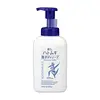What's inside
What's inside
 Key Ingredients
Key Ingredients

 Benefits
Benefits

 Concerns
Concerns

 Ingredients Side-by-side
Ingredients Side-by-side

Water
Skin ConditioningCocamidopropyl Betaine
CleansingSorbitol
HumectantDisodium Laureth Sulfosuccinate
CleansingCocamide Methyl Mea
Sodium Chloride
MaskingDisodium Cocoamphodiacetate
CleansingCocamide Mea
Emulsifying1,2-Hexanediol
Skin ConditioningSodium Benzoate
MaskingCitric Acid
BufferingDisodium EDTA
Butylene Glycol
HumectantPanax Ginseng Root Water
MaskingOphiopogon Japonicus Root Extract
Skin ConditioningAngelica Acutiloba Root Extract
Skin ConditioningBupleurum Falcatum Root Extract
Skin ConditioningPerilla Ocymoides Seed Extract
AntioxidantNatto Gum
Ceramide NP
Skin ConditioningEthylhexylglycerin
Skin ConditioningStearic Acid
CleansingHydroxypropyl Bispalmitamide Mea
EmollientMannitol
HumectantAcrylates/Ammonium Methacrylate Copolymer
Silica
AbrasiveCholesterol
EmollientWater, Cocamidopropyl Betaine, Sorbitol, Disodium Laureth Sulfosuccinate, Cocamide Methyl Mea, Sodium Chloride, Disodium Cocoamphodiacetate, Cocamide Mea, 1,2-Hexanediol, Sodium Benzoate, Citric Acid, Disodium EDTA, Butylene Glycol, Panax Ginseng Root Water, Ophiopogon Japonicus Root Extract, Angelica Acutiloba Root Extract, Bupleurum Falcatum Root Extract, Perilla Ocymoides Seed Extract, Natto Gum, Ceramide NP, Ethylhexylglycerin, Stearic Acid, Hydroxypropyl Bispalmitamide Mea, Mannitol, Acrylates/Ammonium Methacrylate Copolymer, Silica, Cholesterol
Water
Skin ConditioningLauric Acid
CleansingMyristic Acid
CleansingPotassium Hydroxide
BufferingCocamide Mea
EmulsifyingGlycerin
HumectantGlycol Distearate
EmollientCocamidopropyl Betaine
CleansingSodium Laureth Sulfate
CleansingCocamide DEA
EmulsifyingSodium Chloride
MaskingPotassium Cocoyl Glutamate
Sodium Cocoyl Glutamate
CleansingSodium Lauroyl Methylalanine
Sh-Barley Seed Extract
Skin ConditioningButyrospermum Parkii Butter
Skin ConditioningSodium Hyaluronate
HumectantButylene Glycol
HumectantPropylene Glycol
HumectantPolyquaternium-7
Alcohol Denat.
AntimicrobialTetrasodium EDTA
Phenoxyethanol
PreservativeEthylparaben
PreservativeParfum
MaskingWater, Lauric Acid, Myristic Acid, Potassium Hydroxide, Cocamide Mea, Glycerin, Glycol Distearate, Cocamidopropyl Betaine, Sodium Laureth Sulfate, Cocamide DEA, Sodium Chloride, Potassium Cocoyl Glutamate, Sodium Cocoyl Glutamate, Sodium Lauroyl Methylalanine, Sh-Barley Seed Extract, Butyrospermum Parkii Butter, Sodium Hyaluronate, Butylene Glycol, Propylene Glycol, Polyquaternium-7, Alcohol Denat., Tetrasodium EDTA, Phenoxyethanol, Ethylparaben, Parfum
 Reviews
Reviews

Ingredients Explained
These ingredients are found in both products.
Ingredients higher up in an ingredient list are typically present in a larger amount.
Butylene Glycol (or BG) is used within cosmetic products for a few different reasons:
Overall, Butylene Glycol is a safe and well-rounded ingredient that works well with other ingredients.
Though this ingredient works well with most skin types, some people with sensitive skin may experience a reaction such as allergic rashes, closed comedones, or itchiness.
Learn more about Butylene GlycolWe don't have a description for Cocamide Mea yet.
Cocamidopropyl Betaine is a fatty acid created by mixing similar compounds in coconut oil and dimethylaminopropylamine, a compound with two amino groups.
This ingredient is a surfactant and cleanser. It helps gather the dirt, pollutants, and other impurities in your skin to be washed away. It also helps thicken a product and make the texture more creamy.
Being created from coconut oil means Cocamidopropyl Betaine is hydrating for the skin.
While Cocamidopropyl Betaine was believed to be an allergen, a study from 2012 disproved this. It found two compounds in unpure Cocamidopropyl Betaine to be the irritants: aminoamide and 3-dimethylaminopropylamine. High-grade and pure Cocamidopropyl Betaine did not induce allergic reactions during this study.
Learn more about Cocamidopropyl BetaineChances are, you eat sodium chloride every day. Sodium Chloride is also known as table salt.
This ingredient has many purposes in skincare: thickener, emulsifier, and exfoliator.
You'll most likely find this ingredient in cleansers where it is used to create a gel-like texture. As an emulsifier, it also prevents ingredients from separating.
There is much debate on whether this ingredient is comedogenic. The short answer - comedogenic ratings don't tell the whole story. Learn more about comegodenic ratings here.
The concensus about this ingredient causing acne seems to be divided. Research is needed to understand if this ingredient does cause acne.
Scrubs may use salt as the primary exfoliating ingredient.
Learn more about Sodium ChlorideWater. It's the most common cosmetic ingredient of all. You'll usually see it at the top of ingredient lists, meaning that it makes up the largest part of the product.
So why is it so popular? Water most often acts as a solvent - this means that it helps dissolve other ingredients into the formulation.
You'll also recognize water as that liquid we all need to stay alive. If you see this, drink a glass of water. Stay hydrated!
Learn more about Water